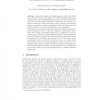370 search results - page 18 / 74 » Limits of Constructive Security Proofs |
TCC
2010
Springer
14 years 3 days ago
2010
Springer
Related-key attacks are attacks against constructions which use a secret key (such as a blockcipher) in which an attacker attempts to exploit known or chosen relationships among ke...
IEEEARES
2008
IEEE
14 years 2 months ago
2008
IEEE
Existing undecidability proofs of checking secrecy of cryptographic protocols have the limitations of not considering protocols common in literature, which are in the form of comm...
MOBIHOC
2010
ACM
13 years 6 months ago
2010
ACM
Barrier coverage is a critical issue in wireless sensor networks for various battlefield and homeland security applications. The goal is to effectively detect intruders that attem...
CRYPTO
2000
Springer
14 years 16 days ago
2000
Springer
Partially blind signature schemes are an extension of blind signature schemes that allow a signer to explicitly include necessary information (expiration date, collateral condition...
CRYPTO
2010
Springer
13 years 9 months ago
2010
Springer
Multiparty computation protocols have been known for more than twenty years now, but due to their lack of efficiency their use is still limited in real-world applications: the goal...

